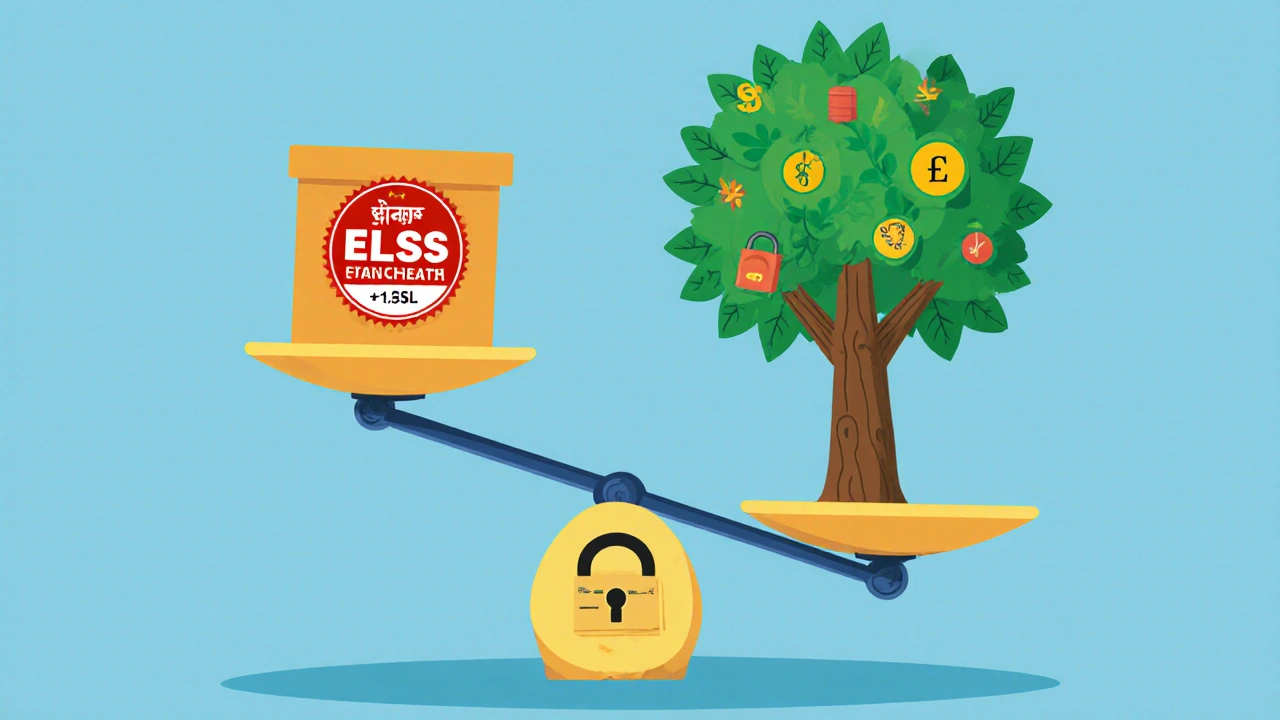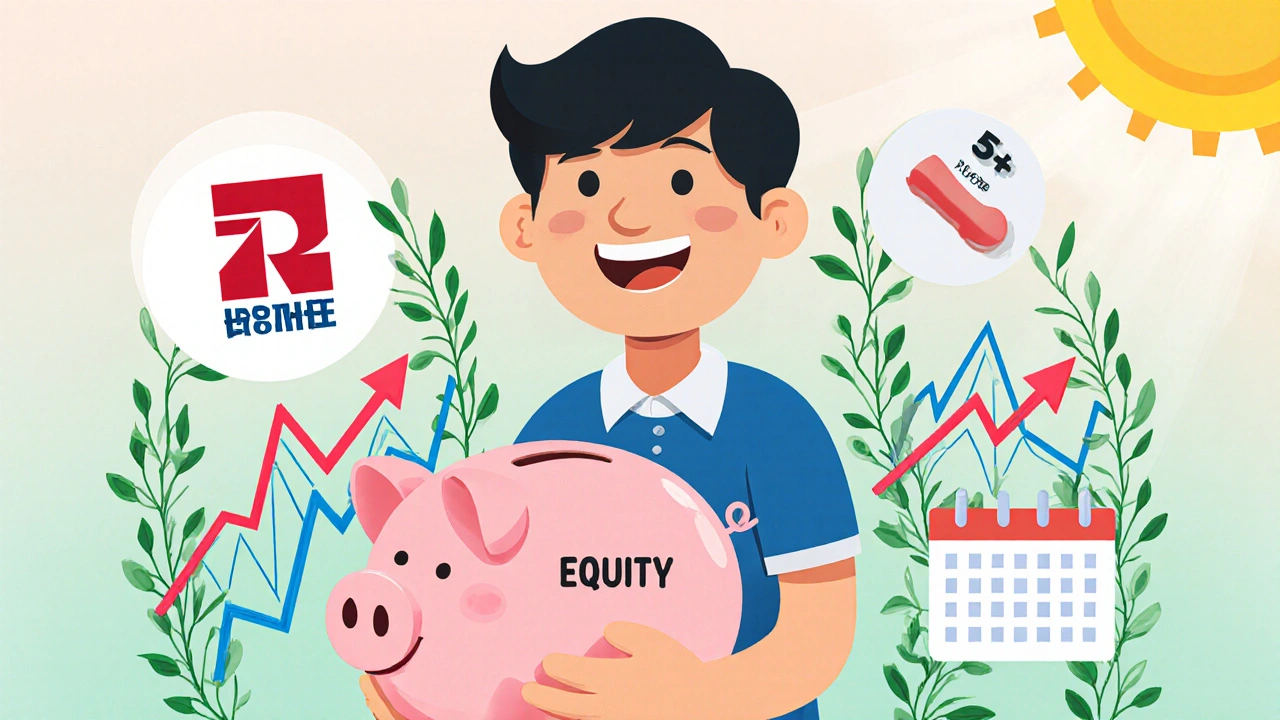Types of Mutual Funds in India: Equity, Debt, Hybrid, and ELSS Explained
When you start investing in mutual funds in India, the sheer number of options can feel overwhelming. But here’s the truth: you don’t need to pick from 5,000 funds. You just need to understand the four main types-Equity, Debt, Hybrid, and ELSS-and match them to your goals, timeline, and comfort with risk. Once you get that right, everything else falls into place.
Equity Mutual Funds: For Growth Over Time
Equity mutual funds invest mostly in stocks. If you’re young, have a long time horizon, and can handle ups and downs, this is where you start. These funds aim for capital growth, not steady income. In India, equity funds made up over 60% of total mutual fund assets in 2025, according to AMFI data.
There are subtypes you’ll see often: large-cap, mid-cap, small-cap, multi-cap, sectoral, and index funds. Large-cap funds buy shares of big, stable companies like Reliance or HDFC Bank. They’re less volatile. Small-cap funds invest in smaller companies with higher growth potential but more risk. Multi-cap funds mix all three, giving you balance without having to pick.
Historically, Indian equity funds delivered an average annual return of 12-14% over the last 15 years. But that doesn’t mean every year is smooth. In 2022, the Nifty 50 dropped nearly 5% in one quarter. If you panic and sell then, you lock in losses. Equity funds work best when held for five years or more.
Debt Mutual Funds: For Stability and Regular Income
Debt funds invest in fixed-income securities like government bonds, corporate debentures, and treasury bills. They’re not for beating the market-they’re for protecting your money and giving you steady returns. If you’re saving for a car in two years, or you’re retired and need monthly cash, debt funds make sense.
Types include liquid funds (for emergency cash), ultra-short duration funds, short-duration funds, corporate bond funds, and gilts (which invest only in government securities). Liquid funds are the safest-they hold securities that mature in under 91 days. They usually return 5-6% annually, with almost no risk of loss.
But don’t assume all debt funds are safe. In 2020, some corporate bond funds lost 8-10% when a major company defaulted. That’s why you should stick to funds managed by big houses with strong credit research teams. Also, avoid long-duration funds if you plan to withdraw within three years. Interest rate changes hit them harder.
Hybrid Mutual Funds: The Middle Ground
Hybrid funds are a mix of equity and debt. They’re designed for people who want some growth but aren’t ready to stomach full stock market swings. Think of them as a safety net with a growth engine.
The most common type is balanced advantage funds. These automatically adjust their equity-debt split based on market conditions. When the market is high, they shift more into debt. When it drops, they buy more equity. This reduces timing risk. Conservative hybrid funds keep 25-40% in equity; aggressive hybrid funds hold 65-80%.
Another popular subtype is equity savings funds. These hold 10-25% in stocks, 10-25% in debt, and the rest in derivatives like arbitrage trades. They’re low-volatility and taxed like equity funds. If you’re new to investing and want to dip your toes in without jumping in headfirst, this is a smart starting point.

ELSS Funds: Tax Saving with Growth
ELSS stands for Equity Linked Savings Scheme. It’s not a separate category-it’s a type of equity fund with a mandatory three-year lock-in. But here’s why it’s special: you get a tax deduction under Section 80C of the Income Tax Act, up to ₹1.5 lakh per year.
That means if you invest ₹1.5 lakh in ELSS, you reduce your taxable income by that amount. If you’re in the 30% tax bracket, that’s ₹45,000 saved in taxes. Plus, your money keeps growing in equities. No other tax-saving instrument offers that combo.
ELSS funds have the shortest lock-in among all 80C options-fixed deposits have five years, PPF has 15. And historically, ELSS funds returned 13-15% annually over the past decade. The lock-in forces discipline. You can’t panic-sell during a downturn. That’s actually a benefit.
Look for funds with a consistent track record over five years, not just the latest top performer. Some ELSS funds take big risks to chase returns. Stick to those with low tracking error and steady performance across market cycles.
How to Choose the Right One for You
Here’s a simple way to decide:
- What’s your goal? Retirement? House down payment? Child’s education? If it’s more than five years away, lean toward equity or ELSS. If it’s under two years, stick with debt or liquid funds.
- How much risk can you handle? If a 10% drop in your portfolio keeps you up at night, don’t put more than 30% in equity. Use hybrid or debt instead.
- Do you need tax savings? If yes, ELSS is your best bet. It’s the only tax-saving fund that also gives you equity growth.
- How often will you add money? If you’re investing monthly through SIPs, you can start with hybrid or balanced funds. They smooth out volatility.
Most people should have a mix. For example: 50% in a multi-cap equity fund, 30% in a balanced advantage fund, and 20% in ELSS. That covers growth, stability, and tax benefits-all in one portfolio.

What to Avoid
Don’t chase past performance. A fund that returned 20% last year might return 5% this year. Look at consistency. Check the Sharpe ratio-it tells you if returns are due to smart investing or just taking wild risks.
Avoid funds with high expense ratios. If a fund charges 2.5% a year and returns 10%, you’re giving away a quarter of your gains. Most good index funds charge under 0.5%. Actively managed funds should justify their fees with clear outperformance.
And never invest without knowing what’s inside. Some ‘debt’ funds hold risky corporate bonds. Some ‘equity’ funds have heavy exposure to just two or three stocks. Read the portfolio breakdown. If you can’t understand it, find a simpler fund.
Where to Start
Start small. Invest ₹500 a month in a good multi-cap equity fund and ₹500 in an ELSS fund. Use a platform like Zerodha, Groww, or Paytm Money. Set up SIPs so you don’t have to think about timing the market.
Review your portfolio once a year. Don’t change it every quarter. If your goals or risk tolerance shift-say, you’re getting closer to retirement-then adjust. Otherwise, let compounding work.
Mutual funds in India aren’t magic. They’re tools. And like any tool, they work best when you use them for what they’re designed for.
What is the safest type of mutual fund in India?
The safest mutual funds in India are liquid funds and ultra-short duration debt funds. These invest in government securities and high-quality corporate bonds with maturities under 90 days. They rarely lose value and typically return 5-6% annually. For emergency cash, these are better than bank savings accounts.
Can I lose money in ELSS funds?
Yes, you can lose money in ELSS funds because they’re equity-based. The market can drop, and your fund’s value can fall. But the three-year lock-in prevents you from selling at a loss during downturns. Historically, ELSS funds have recovered and delivered positive returns over five-year periods. The key is to stay invested through cycles.
Is it better to invest in equity or hybrid mutual funds?
It depends on your risk tolerance and time horizon. If you’re under 35 and investing for retirement, equity funds give you higher growth potential. If you’re 40+ or need steady returns with some growth, hybrid funds like balanced advantage funds are better. They reduce volatility by automatically adjusting between stocks and bonds.
How do I know if a mutual fund is good?
Look at three things: consistency of returns over 5+ years, expense ratio (lower than 1.5% for active funds, under 0.5% for index funds), and portfolio diversification. Avoid funds with too much exposure to one stock or sector. Check the fund manager’s track record and whether the fund has grown assets steadily-not just because of a bull market.
Can I invest in mutual funds without a demat account?
Yes, you don’t need a demat account to invest in mutual funds in India. You can invest directly through fund houses or platforms like Groww, Paytm Money, or Kuvera using just your bank account and PAN. Demat accounts are only needed if you’re buying individual stocks or ETFs.
Next Steps
If you’re just starting, open a free account on a trusted platform. Pick one equity fund, one ELSS fund, and one hybrid fund. Invest ₹1,000 each in SIPs. Set a calendar reminder to review your portfolio in 12 months. That’s it. You don’t need to be an expert-you just need to start.
The market doesn’t reward those who try to time it. It rewards those who stay in it.





